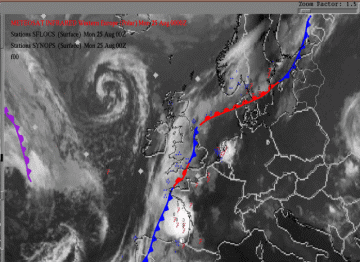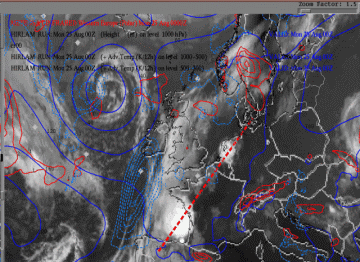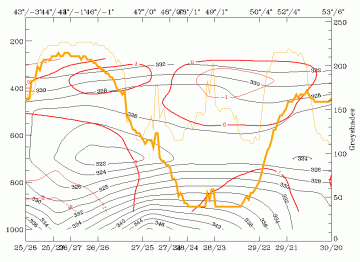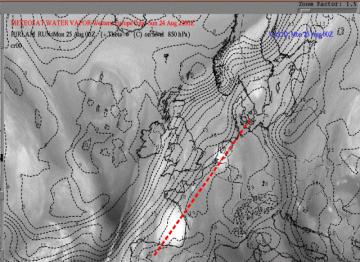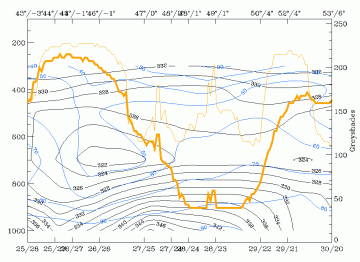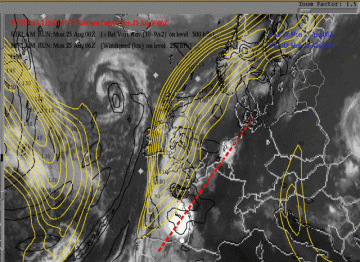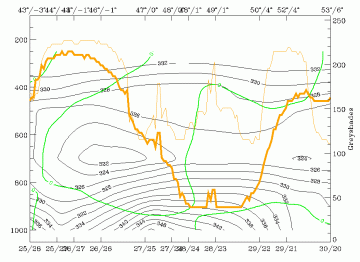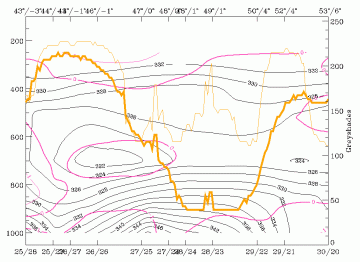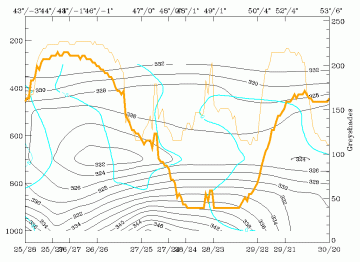24 - 25 August 1997 - Diagnosis 25 August 00.00 UTC
|
25 August 1997/00.00 UTC - Meteosat IR image; weather events (blue: WW code, red: SFLOCS)
|
|
At 00.00 UTC the cluster over the Netherlands was at its most active, with heavy thunderstorms over central Holland and gusts up to 50 kts in a relatively small area.
In the community of de Bilt a downburst caused heavy damage to houses, cars and trees in an area of about one square kilometre. The more extended cluster over the Bay of Biscay was situated not far from an approaching cold front, and it was to be expected that this cluster was under the influence of dynamic forcing.
ABSTOP1000 + WA1000-500 + CA 500-300 + IR + Vertical Cross Section
|
25 August 1997/00.00 UTC - Meteosat IR image; cyan: height contours 1000 hPa, red: temperature advection - WA 1000 hPa, blue:
temperature advection - CA 500 hPa; position of vertical cross section indicated
|
25 August 1997/00.00 UTC - Vertical cross section; black: isentropes (ThetaE), red thin: temperature advection - CA, red thick:
temperature advection - WA, orange thin: IR pixel values, orange thick: WV pixel values
|
Again, in the IR image combined with the temperature advection parameters, no distinct advection was detectable in the area of the investigated cluster. The second cluster, which was originally to the south of the first one, has decayed and its remnant is only visible in the lower IR pixel values. In both cross sections weak warm air advection is present below 700 hPa in the cluster area. At the south-west - north-east cross section some cold advection in the lower levels is visible over Spain - Biscay, which indicates some stabilisation in this area.
Thickness 1000/500/ThetaW 850 hPa + WV + Vertical Cross Section with relative humidity
|
25 August 1997/00.00 UTC - Meteosat WV image; black: wet bulb temperature 850 hPa; position of vertical cross section indicated
|
25 August 1997/00.00 UTC - Vertical cross section; black: isentropes (ThetaE), blue: relative humidity, orange thin: IR pixel values,
orange thick: WV pixel values
|
The cloud cluster over the Netherlands is still within the ThetaW ridge, which is also the case for the cluster over Biscay. In the vertical cross section the instability below 600 hPa is very clearly visible in the Theta values. The humidity values are also high in the lower parts of the atmosphere.
Isotachs 250 hPa >= 60kt + PVA500 >= 2 + IR + Vertical Cross Section
|
25 August 1997/00.00 UTC - Meteosat IR image; black: positive vorticity advection (PVA) 500 hPa, yellow: isotachs 250 hPa; position of
vertical cross section indicated
|
25 August 1997/00.00 UTC - Vertical cross section; black: isentropes (ThetaE), yellow: isotachs, orange thin: IR pixel values, orange
thick: WV pixel values
|
|
25 August 1997/00.00 UTC - Vertical cross section; black: isentropes (ThetaE), green thick: vorticity advection - PVA, green thin:
vorticity advection - NVA, orange thin: IR pixel values, orange thick: WV pixel values
|
|
In the area of the investigated cluster over the Netherlands, no significant values are visible in either the HIRLAM or the ECMWF parameter fields. In the area of the Biscay cluster PVA is calculated in the right entrance of the jet.
Divergence and vertical motion
|
25 August 1997/00.00 UTC - Vertical cross section; black: isentropes (ThetaE), magenta thin: divergence, magenta thick: convergence,
orange thin: IR pixel values, orange thick: WV pixel values
|
25 August 1997/00.00 UTC - Vertical cross section; black: isentropes (ThetaE), cyan thick: vertical motion (omega) - upward motion,
cyan thin: vertical motion (omega) - downward motion, orange thin: IR pixel values, orange thick: WV pixel values
|
In the divergence and omega parameters no significant values are visible in the cluster over the Netherlands. The huge cloud cluster over the Bay of Biscay, however, is strongly under the influence of divergence in the higher levels and, as a consequence, strong upward motion is present.
Summary of diagnosis 00.00 UTC
As was already clear from the 18.00 UTC diagnosis, the investigated cluster developed solely by convection under ideal circumstances: huge instability, high ThetaW 850 values. Dynamical forcing only plays a role in the area of the cluster over the Bay of Biscay.
